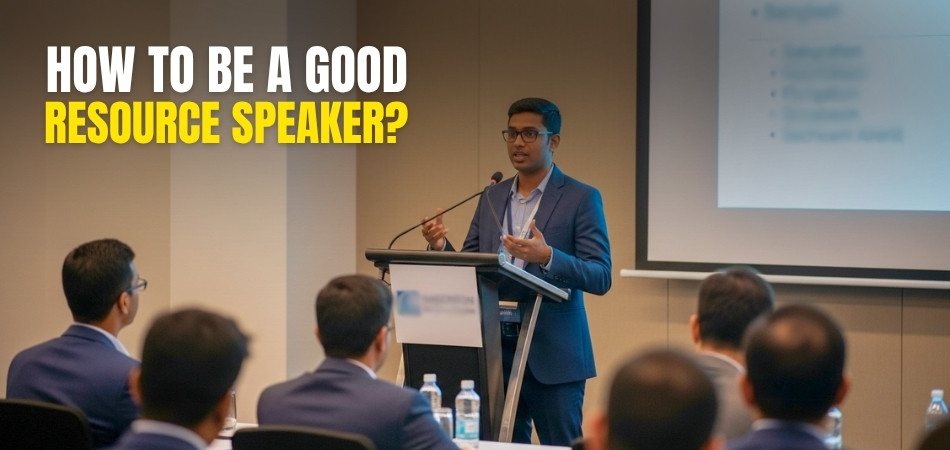Standing in front of a crowd with all eyes on you can feel both exciting and a little scary. A resource speaker isn’t just someone who talks—they’re invited because people believe they have something valuable to share. Whether it’s based on experience, skill, or knowledge, the role carries a sense of trust. That’s why many often find themselves thinking about one important thing: How to be a good resource speaker?
To be a good resource speaker, you must speak clearly, stay on topic, and understand your subject well. Practice before your talk and keep your words simple so everyone can follow. Use real examples to make your points stronger and connect better with listeners. A good speaker also listens, answers kindly, and ends with a message people will remember.
Do you want to learn more about how to speak better and make your message clear? Then keep reading—this article has all the tips and important details you’ll need to become a great resource speaker.
How to Be a Good Resource Speaker?
Speaking in front of people can be exciting and a little scary. But when you’re asked to be a resource speaker, it means others want to learn from you. It’s more than just talking—it’s about sharing something valuable. If you’re wondering how to do it well, keep reading because there’s more to learn ahead.

Know Your Topic
Before anything else, be sure you really understand what you’ll talk about. Read up on the topic and gather the most important points. It helps to list key ideas so you don’t forget them. The more you know, the more confident you’ll feel when speaking. People will trust you more when they see you know your stuff.
Practice Beforehand
Practice helps you feel more comfortable when it’s time to speak. You can try talking in front of a mirror or a friend. This helps you notice if you talk too fast or too slow. It also helps you remember what you want to say. The more you practice, the better you’ll sound.
Be Clear and Simple
Use words that are easy to understand. Avoid using hard or confusing terms just to sound smart. What matters most is that people get your point. Speak slowly and clearly so everyone can follow. Always keep your message simple but meaningful.
Connect With the Audience
Make eye contact and smile when you speak. It helps people feel more connected to you. Try to sound friendly, not like you’re reading a script. If you feel relaxed, the audience will feel relaxed too. A small joke or story can also make your talk more fun.
Stay on Topic
It’s easy to go off track, especially when you’re excited. But it’s important to stick to the topic you were asked to talk about. Keep your ideas in order so they make sense. Don’t spend too much time on one point. This keeps your talk clear and easy to follow.
Use Real Examples
People understand better when you give real-life examples. It makes your talk more interesting and easier to remember. Try to share a short story or something you’ve seen or done. For example, if you’ve attended events like conferences in USA or other places, you can use those experiences to explain your topic better. This helps your message feel more real and personal.
Listen and Respond
Sometimes, people will ask questions or share their thoughts. Listen carefully and respond kindly, even if you don’t agree. If you don’t know the answer, it’s okay to say so. You can always promise to check and share later. What matters is how you treat people when they talk to you.
End Strong
Finish your talk with a short, clear message. You can repeat the most important idea so people remember it. Say thank you and smile before leaving the stage. A strong ending leaves a good impression. It makes people feel glad they listened to you.
What Makes a Resource Speaker Different From a Regular Speaker?
There are special things that set a resource speaker apart from a regular speaker. Both share ideas, but the way they do it is often different. Let’s look at what makes a resource speaker unique.
| Aspect | Resource Speaker | Regular Speaker |
| Purpose | Shares expert knowledge or skills on a specific topic. | May speak for general ideas or entertainment. |
| Topic Depth | Goes deeper into the subject with clear facts or experience. | Usually covers the topic in a broad or light way. |
| Goal | Helps others learn or understand something clearly. | Often speaks to inspire, motivate, or entertain. |
| Style | More focused and informative. | Can be casual, fun, or emotional. |
| Audience Needs | Talks are based on what the audience wants to learn. | May speak based on personal style or message. |
| Preparation | Researches and plans carefully to support the topic. | May be loosely based on personal stories or general points. |
| Content Support | Often uses slides, data, or handouts to explain ideas. | May speak with little or no extra tools. |
| Interaction | Encourages questions and gives helpful answers. | May or may not involve the audience during the talk. |
| Follow-up | Can offer extra resources or ways to learn more after the talk. | Often ends the talk without a follow-up. |
| Setting | Often invited to learning events like workshops or conferences. | Can speak at events, shows, or ceremonies. |
Why Does Time Management Matter When Giving a Talk as a Resource Speaker?
Giving a talk can be fun, but it also needs a little planning to go well. One big thing that helps is how you use your time while speaking. It’s not just about watching the clock—it’s much more. Let’s take a closer look and see why time really matters.
Keeps You Focused
Managing your time well helps you stay focused on your main message. It’s easy to drift into extra details or stories, but sticking to a time limit keeps your talk clear and on point. You avoid wasting minutes and make sure your strongest ideas come through without feeling rushed. Staying aware of time keeps your presentation sharp and meaningful.
Respects the Audience
People give their time to listen to you, so it’s only fair to respect that. If you go way over the time limit, some people may lose interest. They might even feel bored or tired. But if you finish on time, they’ll remember your talk in a good way.
Covers All Points
Planning your time in advance ensures you cover all the key points without missing anything important. You’re less likely to skip sections or rush through ideas at the end. Each part of your talk gets the attention it deserves, making your message clear and easy to follow. The result is a presentation that feels complete, not scattered or unfinished.
Avoids Rushing
Sometimes speakers run out of time and rush through the last part. That makes it hard for people to understand what’s being said. When you manage your time, you speak at a good pace from start to finish. It also helps you stay calm and confident. People enjoy your talk more when it doesn’t feel rushed.
Time for Questions
If you plan your time right, you might even have a few minutes left at the end. This is great for answering questions or hearing what others think. It shows you’re open and friendly. People like being part of the talk as well. A few minutes for questions can make your talk even better.
Shows You’re Prepared
When your timing is just right, it tells people you’ve practiced. It shows that you came ready and that you take the talk seriously. This makes you look confident and skilled. People pay more attention when they see you’re well-prepared.
Leaves a Good Ending
The way you end your talk really matters. If you run out of time, your ending can feel weak or sudden. But with good timing, you can close your talk with a strong final message. You can say thank you and end with a smile. A nice ending helps people remember your words in a good way.
How to Adapt Your Talk Based on Audience Type as a Resource Speaker?
Every audience is different, and the way you speak should match who’s listening. Some groups like things simple, while others enjoy more detailed talks. To make your message clear, you have to speak in the right way. Let’s look at how you can change your talk for different types of people.
Know Who’s Listening
Before you start, find out what kind of group you’ll be talking to. Are they professionals, teachers, or a mix of people? This helps you decide how serious or casual your talk should be. You’ll also know what kind of words and examples to use. The more you know about your listeners, the better your talk will go.
Adjust Your Tone
Your tone is how you sound when you speak. If you’re talking to a corporate group, your tone should be more serious and respectful. But if the group is more casual or mixed, a friendly and relaxed tone works better. Try not to sound too stiff or too silly. Just match the mood of the people in front of you.
Use the Right Words
Choose words that your audience can easily understand. In an academic group, it’s okay to use more detailed words and ideas. But in a mixed or general group, keep things simple and clear. Don’t use big or strange words just to sound smart. Speak so everyone can follow along without getting lost.
Match the Content
The depth of your talk should match who’s listening. For a corporate or academic group, you can go deeper into facts, details, and examples. But if the audience is more general, stick to the basics and keep things easy to follow. Always check if your examples fit the group you’re talking to. What works for one group might confuse another.
Keep It Relevant
People pay more attention when your talk feels useful to them. Try to give examples that fit their world. If you’re speaking at a company, talk about real work situations. In an academic talk, include research or facts. For a mixed group, balance it out so everyone gets something from your talk.
Watch Their Reactions
As you speak, look at how people react. Are they nodding or looking confused? If they look bored or lost, you might need to slow down or change how you’re speaking. Sometimes, just a small change in your tone or words can help a lot. Being alert during your talk helps you connect better.
Be Flexible
Not every talk will go as planned, and that’s okay. Be ready to change your tone or skip some parts if the audience needs something different. You don’t have to follow your script word for word. What matters most is making sure your message is clear and helpful. Good speakers can adjust as they go.
Tips on Building Credibility as a Resource Speaker
Trust is one of the most important things you can earn when giving a talk. If people believe in you, they’ll listen more and remember what you say. But trust doesn’t happen by accident—it comes from small actions and choices. Here are some simple ways to build strong credibility as a speaker:
Be on Time
Showing up on time tells people that you respect them. If you’re late, it can make others feel like their time doesn’t matter to you. Arriving early also gives you time to get ready and feel calm. It shows you’re serious about your talk. Being on time is a small thing that makes a big impact.
Listen to Others
Being a good speaker also means being a good listener. If someone asks a question or gives feedback, listen carefully. Don’t interrupt or ignore what they say. People trust speakers who listen and respond kindly. It shows you care about what others think.
Stay Updated
Even if you’ve spoken about a topic many times, always check if there’s anything new. Things change fast, and giving old or wrong info can hurt your credibility. Reading fresh news or updates before your talk helps you stay sharp. People will trust you more if they feel your ideas are current.
Use Simple Tools
You don’t need fancy slides or big words to sound smart. Even a simple chart or picture can help people understand your point better. If you use tools, keep them clean and easy to follow. Good visuals make you look more prepared and thoughtful. They support your words without taking over.
Give Credit
If you’re sharing an idea that’s not yours, say where you got it from. This shows that you’re honest and respectful. Giving credit makes you look fair and trustworthy. People will see that you don’t try to take credit for something you didn’t create. It also shows that you value other people’s work.
Stay Calm Under Pressure
Sometimes things don’t go as planned—maybe a tech issue or a tough question. If you stay calm and handle it with a smile, people will respect you more. Getting upset or nervous can break the mood. But if you stay cool, people will trust you to handle anything.
Speak for the Audience
Think about what the audience wants or needs from your talk. Try not to speak just for yourself or to show off what you know. If you understand the role of a resource speaker, it becomes easier to shape your message in a way that helps the audience learn and stay interested. A speaker who puts the audience first always stands out. This makes people feel heard and valued.
Common Mistakes to Avoid as a Resource Speaker
Speaking in front of a group can be exciting, but it’s easy to make small mistakes without realizing it. These mistakes can make your talk confusing or hard to follow. Knowing what to avoid can really help your talk go better. Let’s go over some common mistakes you should watch out for:
Too Much on Slides
Slides should help people understand, not confuse them. When you add too many words or pictures, it can be hard to read and follow. People might focus on reading instead of listening to you. Keep slides simple, clear, and easy to read. Just a few key points or images are enough.
Being Too Technical
Using big or hard-to-understand words can turn people off. It’s easy to lose the audience if they don’t understand what you’re saying. You don’t need to sound super smart—you just need to be clear. Speak in a way that most people can follow. If a word sounds too complicated, find a simpler one.
Ignoring Time Limits
Going over your time makes your talk feel long and tiring. It also takes time away from other speakers or activities. People may stop paying attention if your talk drags on. Always plan your talk to fit the time you’re given. Finishing on time shows you’re respectful and prepared.
No Audience Connection
Some speakers talk like they’re reading a paper. That makes it hard for people to feel interested. Try to make eye contact and use a friendly tone. A smile or simple story can help people feel more connected. If you don’t connect, they may stop listening—even if your topic is good.
Talking Too Fast
Feeling nervous can often lead to speaking too fast, which makes your message harder to follow. Listeners need a moment to process what you’re saying. Slowing down, pausing briefly, and remembering to breathe can make your talk clearer and more engaging. A calm pace helps your audience stay connected from start to finish.
Not Practicing Enough
Some people think they can just talk without practicing. But even short talks need some practice to go well. If you don’t practice, you might forget what to say or talk in circles. Practice helps your talk sound smooth and clear. It also makes you feel more ready.
How to Handle Nerves and Build Confidence Before Speaking as a Resource Speaker?
Getting nervous before speaking is normal. Even great speakers feel it sometimes. But with a few small habits, you can feel calmer and more sure of yourself before facing an audience. Here is how to handle nerves and build confidence before speaking:
| Tip | What to Do | Why It Helps |
| Deep Breathing | Take slow, deep breaths before you go on stage. | It helps calm your body and slow down your heartbeat. |
| Practice Out Loud | Say your talk out loud several times at home. | The more you practice, the less nervous you’ll feel. |
| Prepare Early | Get your talk ready days before the event. | Feeling prepared takes away most of the stress. |
| Visualize Success | Close your eyes and imagine yourself doing well. | Positive thinking builds real confidence. |
| Use Notes Wisely | Bring short notes or bullet points with you. | They help you stay on track without reading word for word. |
| Dress Comfortably | Wear something neat that you feel good in. | Feeling good in your clothes adds to your confidence. |
| Think About the Audience | Remind yourself they want to learn, not judge. | This makes the room feel friendly, not scary. |
| Avoid Last-Minute Changes | Stick with what you practiced. | Changing things last-minute can add more stress. |
| Drink Water | Take a few sips of water before starting. | It keeps your throat clear and gives you a moment to pause. |
| Smile at the Start | Smile as you begin your talk. | A smile helps relax you and makes the audience feel good too. |
Feeling nervous doesn’t mean you’re not ready—it just means you care. Use these tips to calm your mind and get into the right mood before speaking. Confidence grows with practice, so keep going and trust yourself.
Should Resource Speakers Submit Supporting Materials Before Their Talk?
Yes, resource speakers should submit supporting materials before their talk, and there are good reasons why this simple step really matters. Organizers often need time to review and arrange materials ahead of the session to avoid confusion. When slides, handouts, or videos are sent early, it helps fix any small issues before the talk begins. It also gives the event team enough time to prepare backup plans if there are any last-minute technical problems.
Sharing your materials early also shows that you are ready and take the event seriously, which builds trust with the team. Sometimes, organizers need these files to translate, print, or upload them for the audience. Many events also ask speakers to write a good abstract for a conference paper, which helps explain the talk in a simple way. Giving useful materials on time makes your talk easier to understand and helps listeners follow what you are saying.
Lastly, having everything sorted before the actual talk lets you focus on speaking clearly and connecting with your audience, not rushing. It saves you from worrying about missing files, broken links, or last-minute edits. When you’re prepared, you feel more relaxed and confident while speaking in front of people.
Tips for Creating Powerful Presentation Slides as a Resource Speaker
Making great slides helps people understand your message better and keeps them interested from start to finish. The way you design and use slides matters a lot for a good talk. Here are some simple but strong tips to create slides that really work.
- Keep Slides Simple: Too much on one slide can be distracting and hard to follow. Show one idea at a time to keep things clear.
- Use Big Fonts: Small text makes people squint or stop reading completely. Use large, readable fonts so everyone can see your words easily.
- Stick to One Style: Changing styles on every slide makes your talk feel messy. Use the same font, colors, and layout throughout the presentation.
- Limit Text Blocks: Don’t fill your slides with long paragraphs or full sentences. Use short points or phrases that support what you are saying.
- Avoid Slide Clutter: Too many shapes, images, or charts can confuse the audience. Keep only what’s needed and remove anything that feels extra.
- Choose Clear Colors: Make sure there is enough contrast between your text and background. Light text on dark backgrounds or dark on light works best.
- Use Helpful Visuals: Pictures or charts should help explain your topic, not replace your message. A good visual makes your point easier to understand.
- Don’t Overuse Effects: Animations and transitions can be fun, but too many are distracting. Use them only when they help show something clearly.
- One Message Per Slide: Try not to mix topics on the same slide. It’s easier to follow when each slide focuses on just one clear idea.
- Test Slides Beforehand: Always check your slides on the actual screen you’ll use. What looks fine on a laptop may look different when presented.
How to Leave a Lasting Impression as a Resource Speaker?
What you say at the end of your talk matters just as much as the beginning. It’s your last chance to make people remember you. A strong ending helps your message stay with the audience even after the talk ends. Let’s explore some easy ways to leave a good impression.
Repeat the Main Point
Before ending, go back to the most important idea you shared. Say it again clearly so people remember it. This helps the audience understand what they should take away. A strong message at the end sticks better than many small ones. Keep it short but powerful.
Share a Simple Quote
A short quote can help sum up your message in a nice way. Choose one that fits your topic and is easy to remember. It adds feeling to your ending without being too long. The right quote can stay in people’s minds for a long time. Just make sure it feels natural and not forced.
Thank the Audience
Always take a moment to say thank you. It shows respect and leaves a warm feeling in the room. People remember how you made them feel, not just what you said. A kind thank-you message makes the ending feel complete. Smile and show that you truly mean it.
Ask a Quick Question
You can leave your audience thinking by asking a short and smart question. It should make them reflect on your topic. Don’t ask something hard—just something that keeps the idea alive. A good question can stay in their heads even after they leave. It’s a nice way to end with meaning.
Give Something to Take
If possible, give a short handout or list with key points. It helps people remember what you said even days later. A simple sheet or card can be enough. Make it clear and easy to read. Small take-home items can make a big impact.
Offer to Follow Up
Let the audience know how they can reach you later if they have more questions. Share an email or page where they can learn more. This shows you care about helping, not just talking. It also builds trust and keeps the connection going. People feel valued when you stay open.
Tell a Short Story
End your talk with a quick story that fits your message. Stories are easy to remember and fun to hear. They bring feeling to your words and make your talk feel real. Even a small story can leave a strong memory. Just keep it short and clear.
Leave With Energy
Don’t end your talk flat or quiet. Leave with energy; even a small smile or upbeat tone can help. Let your last words sound strong and full of life. This makes the audience feel good about your message. A bright ending is always better than a dull one.
FAQs About How to Be a Good Resource Speaker?
Becoming a good resource speaker takes more than just standing in front of a crowd and speaking. Many people have questions about the smaller details that help make a talk stronger, smoother, and more helpful. Below are answers to some common and useful questions that haven’t been covered yet in the content above.
How Can I Keep My Voice Steady While Speaking?
To keep your voice steady, practice speaking slowly and clearly during your prep time. Take a deep breath before each main point to help calm your nerves. Drink water before your talk to keep your throat clear. Most importantly, stay relaxed and don’t rush your words.
What If the Audience Looks Uninterested?
If your audience looks bored, try to change your tone or ask a simple question to re-engage them. Use a short story or real-life example to draw their attention back. Keep your energy up without sounding forced. Watching their reactions helps you adjust on the spot.
Should I Move Around While Speaking?
Yes, but do it naturally. Walking slowly across the space or using hand gestures adds energy to your talk. Don’t pace back and forth too much—that can distract people. Movement should match your words, not take attention away from them.
How Do I Handle a Tech Failure During My Talk?
Stay calm and don’t panic. Keep talking using your notes while someone helps fix the issue. Avoid staring at the screen or apologizing too much. Being calm shows you’re in control and can handle problems without stress.
What Should I Do If I Forget a Part of My Talk?
Pause for a moment and look at your notes or slide to refresh your memory. Don’t say “I forgot”—just smoothly move to the next point. Most people won’t even notice the mistake. Staying calm helps you recover quickly.
Can I Use Humor in My Talk?
Yes, a small joke or funny story can help people relax and connect with you. But keep it simple and respectful. Avoid jokes that could offend or confuse the audience. Use humor only when it fits naturally with your topic.
What If I Speak Too Fast Without Noticing?
Ask a friend to watch you speak and give feedback. You can also record yourself to check your pace. If you notice you’re rushing, take small pauses between sentences. This makes your talk easier to follow and helps you stay in control.
End Note
Being a good speaker isn’t about being perfect—it’s about being real, prepared, and clear with your message. People remember how you made them feel, what you helped them understand, and how easy it was to connect with you. A few honest words and a well-prepared talk can go a long way.
If you’ve ever asked yourself how to be a good resource speaker, the answer is simple: care about what you say and who’s listening. Speak with heart, stay on topic, and make sure your ideas are easy to follow. You don’t have to use big words or be the loudest voice—just be clear, kind, and ready.
Remember, your voice matters, and someone out there is waiting to learn something new from you. So, take a deep breath, smile, and share what you know with confidence. That’s how to be a good resource speaker others will remember.








